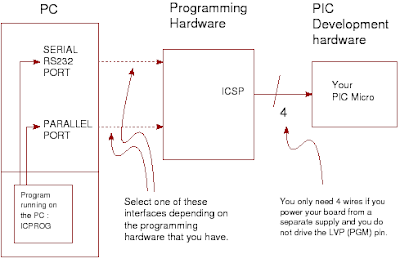Uhh...saya mau fokus satu-persatu dulu
ada judul e-book
EMBEDDED
SYSTEMS
PROGRAMMING
WITH THE
PIC16F877
196 halaman, mau saya terjemmahkan dulu
=============================================================
Ini daftar isinya:
Table of Contents
Preface …………………………………………………………………. 5
List of Figures …………………………………………………………. 6
Abbreviations and Acronyms …………………………………………. 7
Trademarks ……………………………………………………………. 10
Chapter 1 Introduction to ESP and the PIC …………………………. 11
Chapter 2 Microcontrollers and the PIC16F877 ……………………. 15
Section 2.0 Chapter Summary ……………………………….. 15
Section 2.1 Memory and Memory Organization ……………. 15
Section 2.2 The PIC16F877 …………………………………. 16
Section 2.3 Programming the PIC …………………………… 17
Chapter 3 Simple PIC Hardware & Software (“Hello World”) …….. 20
Section 3.0 Chapter Summary ……………………………….. 20
Section 3.1 A Simple Example System ……………………… 20
Section 3.2 Summary of Instructions and Concepts …………. 25
Chapter 4 The PIC Instruction Set (Part I) ………………………….. 27
Section 4.0 Chapter Summary ………………………………. 27
Section 4.1 The PIC16F877 Instruction Set ………………… 27
Section 4.2 Summary of Instructions and Concepts …………. 33
Chapter 5 The PIC Instruction Set (Part II) …………………………. 34
Section 5.0 Chapter Summary ……………………………….. 34
Section 5.1 Introduction ……………………………………… 34
Section 5.2 Keypad and Display Interface …………………… 35
Section 5.3 The STATUS Register and Flag Bits ……………. 39
Section 5.4 The Keypad Software ……………………………. 40
Section 5.5 The LED Display Software ……………………… 43
Section 5.6 Improved Display and Indirect Addressing ……… 46
Section 5.7 Odds & Ends …………………………………….. 50
Section 5.8 Using KEY_SCAN and DISPLAY Together ……. 54
Section 5.9 A Last Look at the Advanced Security System ….. 56
Section 5.10 Summary of Instructions and Concepts ………… 57
Chapter 6 Fundamental ESP Techniques ……………………………. 59
Section 6.0 Chapter Summary ………………………………… 59
Section 6.1 Introduction ………………………………………. 59
Section 6.2 Software Readability …………………………… 59
Section 6.3 Software Maintainability …………………………. 60
Chapter 6
Section 6.4
Software Fundamentals ………………………….. 60
Section 6.5 The Background Routine ………………………… 61
Section 6.6 The Watch-Dog Timer …………………………… 61
Section 6.7 Event-Driven Software …………………………... 62
Section 6.8 Interrupts …………………………………………. 65
Section 6.9 Slow Inputs and Outputs …………………………. 65
Section 6.10 Software Time Measurement …………………… 66
Section 6.11 Hashing …………………………………………. 67
Section 6.12 Waveform Encoding ……………………………. 68
Section 6.13 Waveform Decoding …………………………… 71
Section 6.14 RAM, ROM, and Time Tradeoffs ……………… 75
Section 6.15 ROM States ……………………………………... 75
Section 6.16 Limitations of C/C++ …………………………… 76
Chapter 7 Advanced ESP ……………………………………………. 78
Section 7.0 Chapter Summary ………………………………… 78
Section 7.1 Introduction ………………………………………. 78
Section 7.2 Sine Wave Generation …………………………….78
Section 7.3 Dual-Tone-Multi-Frequency (DTMF) Signaling …81
Section 7.4 Pulse-Width Modulation ………………………….82
Section 7.5 ADPCM Data Compression ………………………84
Section 7.6 Test Functions and System Ideas …………………87
Chapter 8 PIC Peripherals and Interrupts ……………………………91
Section 8.0 Chapter Summary ………………………………...91
Section 8.1 Overview of the PIC Peripherals …………………91
Section 8.2 Input/Output Ports ………………………………..93
Section 8.2.1 Port A ………………………………………….. 93
Section 8.2.2 Port B, Port C, Port D ………………………….. 95
Section 8.2.3 Port E ………………………………………….. 95
Section 8.3 Interrupts …………………………………………. 95
Section 8.4 ADC and Analog MUX ………………………….. 98
Section 8.5 Watch-Dog Timer ………………………………... 102
Section 8.6 Timer 0 …………………………………………… 103
Section 8.7 Timer 1 ………………………………………….. 105
Section 8.8 Timer 2 ………………………………………….. 106
Section 8.9 Capture Mode …………………………………… 107
Section 8.10 Compare Mode ………………………………… 109
Section 8.11 Pulse-Width Modulation (PWM) ……………… 111
Section 8.12 Parallel Slave Port ……………………………… 114
Chapter 8 Section 8.13 EEPROM Data Memory ………………………… 116
Section 8.14 FLASH Program Memory ………………………. 117
Section 8.15 FLASH Code & Data EEPROM Protection ……. 118
Section 8.16 The CONFIGURATION Word ………………… 119
Section 8.17 Sleep Modes & Reset Modes …………………… 120
Chapter 9 PIC Peripherals, Serial Communications Ports ……………122
Section 9.0 Chapter Summary …………………………………122
Section 9.1 Introduction ……………………………………….122
Section 9.2 USART (Overview) ………………………………122
Section 9.2.1 USART (Asynchronous Mode, Full-Duplex) …..123
Section 9.2.2 USART (Synchronous, Master Mode) ………… 127
Section 9.2.3 USART (Synchronous, Slave Mode) ………….. 128
Section 9.3 Serial Peripheral Interface (Master Mode) ………. 128
Section 9.4 Serial Peripheral Interface (Slave Mode) …………132
Section 9.5 I2C System Overview …………………………….134
Section 9.5.1 I2C Slave Mode …………………………………137
Section 9.5.2 I2C Master Mode ………………………………. 139
Chapter 10 DSP Fundamentals ……………………………………… 147
Section 10.0 Chapter Summary ………………………………. 147
Section 10.1 Introduction …………………………………….. 147
Section 10.2 An Example: A Low-Pass Filter ……………….. 148
Section 10.3 An Example: A High-Pass Filter ………………. 148
Section 10.4 DSP Filters in General ………………………… 149
Section 10.5 Aliasing and the Nyquist Sampling Theorem ……149
Section 10.6 DSP Cookbook I: A Simple LPF/HPF …………. 151
Section 10.7 DSP Cookbook II: A Simple BPF ……………… 152
Section 10.8 DSP Cookbook III: A Median Filter …………… 153
Section 10.9 DSP Example I: Standard DTMF Decoding …….154
Section 10.10 DSP Example II: Alternative DTMF Decoding .. 155
Section 10.11 DSP Application: Speech Compression ………… 159
Appendix A The PIC16F877 Instruction Set ………………………….. 163
Appendix B Useful C++ Programs for PIC ASM Applications ………. 180
Appendix C Special Function Registers (RAM Addresses & Bits) ……185
Appendix D PIC16F877 Register File Map ……………………………191
Appendix E PIC16F877 Pin Function Map ……………………………192
Appendix F Save/Restore Registers on Interrupt ……………………… 193
References ………………………………………………………………. 195
===============================================================
dibantu oleh Google Translate......





















